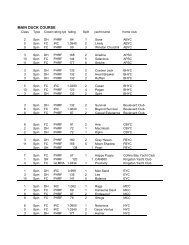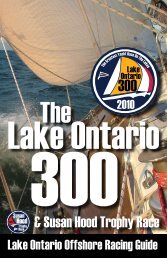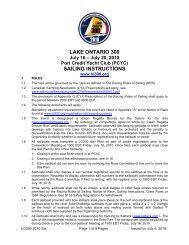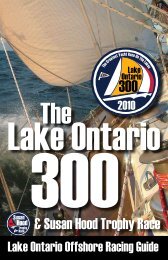Create successful ePaper yourself
Turn your PDF publications into a flip-book with our unique Google optimized e-Paper software.
Page 98 <strong>Lake</strong> <strong>Ontario</strong> <strong>Offshore</strong> Racing Guide <strong>Lake</strong> <strong>Ontario</strong> <strong>Offshore</strong> Racing Guide Page 99<br />
wind and upwind legs. In that case the concern is that you may not be sailing<br />
the optimum angles. Too high for the down-wind leg and too low for the beat.<br />
So why not simply use VMG? You can and the AVIA system also shows VMG<br />
but I find it tricky to use as an instant indicator of sailing efficiency. It provides<br />
a good indication of progress over a longer period of time but small heading<br />
changes initially give an impression of improved progress until the speed bleeds<br />
off resulting in an unstable hunting for the magic combination of speed and<br />
heading. Target speeds are a more direct indication of how you’re doing.<br />
To help with this concept we put in 2 versions of the polar charts. The normal<br />
version that gives the VPP for any combination of true wind angle and wind<br />
speed and a special version for windward/leeward situations that forces a<br />
“fixed” target speed for a given wind speed regardless of the actual wind angle<br />
whenever the boat is close to beating or running angles. For instance, if the true<br />
wind angle is less than 52 degrees, the programme gives the best beating target<br />
speed and “coaches” the helmsman to the best target for beating at that particular<br />
wind speed. A simple click of the mouse selects between polar charts while<br />
the programme is operational.<br />
The polars are easy to install from a spreadsheet and the system logs all the<br />
data on the computer for later review and fine tuning the polar data.<br />
So what about instrument sensors? That question eventually led me to the<br />
NMEA 2000 network and the “intelligent” sensors that put information directly<br />
on the network. One of the most interesting developments since I last looked<br />
at the state-of-the-art is the ultrasonic wind sensors. These have no moving<br />
parts and use ultrasonic sensors and<br />
receivers to detect wind flow across<br />
the sensing area.<br />
I found two manufacturers that build<br />
sensors suitable for a sailboat, Maretron<br />
and Airmar. The published specifications<br />
on accuracy did not look too<br />
promising but I wanted to see how<br />
well they worked. The answer was<br />
to build a small wind tunnel in the<br />
sailloft that could generate up to 12<br />
knots of breeze and test these sensors<br />
as well as a conventional masthead<br />
wind sensor.<br />
The results were pretty good, much<br />
better than the published specifications.<br />
The average absolute error for<br />
both ultrasonic sensors was about<br />
3/4 of one degree with a few readings<br />
2 degrees out. The conventional<br />
Furuno masthead sensor we tested was dead on with no measurable error with<br />
our setup.<br />
What finally swayed my choice to the Airmar PB200 was that it also has a GPS,<br />
a fluxgate compass, barometric pressure, air temperature and heel and pitch<br />
angle all built into one device the size of small coffee cup. We built a mount<br />
that elevates the sensor about 4 feet above the masthead and it seems to benefit<br />
from being in clear air away from the sails and mast.<br />
The system worked well during the 2010 season with 2 exceptions. During the<br />
second thunderstorm in the LO<strong>300</strong>, the wind sensor shut down completely, no<br />
reading at all. It resumed normally after the lightening had moved away. The<br />
other time was the LOSHRS 100 mile race during the heaviest downpour. The<br />
wind angle shifted 20 degrees to port but returned to normal when the rain<br />
diminished to “moderate” levels. One remarkable feature of the ultrasonic wind<br />
sensor is how well it works in very light winds. In the last LOSHRS race from<br />
Dalhousie we were able to use this feature to get across the quiet spot in the<br />
middle of the lake.<br />
For displays, we experimented<br />
with a number of options<br />
through the 2010 season. For<br />
the computer I initially used<br />
an IBM laptop that I could see<br />
from the helm. We also had a<br />
Maretron DSM 250 that was<br />
useful for the longer races<br />
because it didn’t take as much<br />
battery power. At the end of<br />
the season we installed the<br />
software on an HP netbook<br />
that provided enough computing<br />
power, a handy size and doesn’t take too much battery power to operate.<br />
For the 2011 season I added an Argonaut Proteus 10”, daylight viewable, waterproof<br />
VGA display to make all the features including chart plotter available in<br />
the cockpit.<br />
So for the 2011 season we will start with the Airmar ultrasonic wind sensor<br />
mounted on a 4’ tall custom-carbon wand on top of the mast, an Airmar boat<br />
speed, water temperature and depth transducer, both communicating over a<br />
an NMEA 2000 network through an Actisense USB interface to the netbook.<br />
The netbook at the navigation station has the AVIA Pro software and Fugawi<br />
ENC chart plotter software and the display in the cockpit will be the Argonaut<br />
10” monitor. If we decide we need additional repeaters in the cockpit we can<br />
always add individual repeaters or the Maretron display to the NMEA 2000<br />
network, at any time.<br />
Now, the question is, will we get 25 years out of the system?










